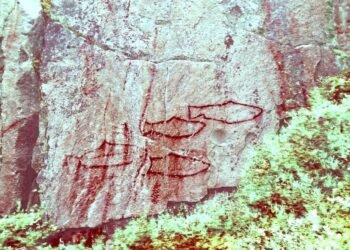Archaeologists have made a series of remarkable discoveries at the Roman fort of Apsaros in present-day Georgia, highlighting the site’s religious, economic, and military significance during the Roman period.

The Polish-Georgian team, led by Radosław Karasiewicz-Szczypiorski from the Polish Centre of Mediterranean Archaeology (University of Warsaw) and Lasha Aslanishvili from Georgia’s Cultural Heritage Protection Agency of Adjara, conducted excavations from mid-May to late July 2024.
Among the season’s most remarkable finds was a thin gold votive plaque dedicated to Jupiter Dolichenus, an ancient Roman deity associated with war and revered by soldiers. The plaque, inscribed in Greek, reflects a unique merging of cultural elements, combining the attributes of the Roman god Jupiter, known for storm and lightning, with Dolichenus, a Near Eastern thunder deity whose cult originated in what is now southeastern Turkey.
The team believes that the discovery of this plaque suggests the presence of a sanctuary dedicated to Jupiter Dolichenus near the Apsaros fort, which has yet to be found. According to Karasiewicz-Szczypiorski, “We hope that further research will not only find the temple of Jupiter of Dolichenus at Apsaros, but also confirm that Oriental influence spread west and north to many garrisons.” Such a sanctuary would likely have served as a place where Roman soldiers made offerings in hopes of securing the deity’s favor in battle.

The excavation also revealed the remains of kilns used for producing amphorae—ceramic vessels often used to store and transport wine. This discovery, combined with an earlier find of a wine press, indicates that Apsaros was likely a center for local wine production. The amphorae, known as Colchian amphorae, were commonly used around the Black Sea region, supporting the theory that local wine was produced and exported from this location. “We can therefore assume that the amphorae were filled with local wine and exported to other garrisons and ports on the Black Sea,” Karasiewicz-Szczypiorski shared with Newsweek.
Another noteworthy finding at Apsaros was a mosaic within the residence of the garrison commander, known as Arrian’s House. This mosaic, which the archaeologists believe suffered displacement due to an earthquake, displays fragments of red and pink lines on a white background, hinting at a geometric design. “Due to the extensive damage to the new mosaic, we are still analyzing and piecing together its pattern,” Lockley noted, adding that some of the most fragile sections have been moved to a local museum for preservation.

The excavations at Apsaros, situated in Georgia’s modern-day Adjara region near Batumi, highlight the fort’s strategic role during the Roman period as a military base and a port on the eastern coast of the Black Sea. Established around 2,000 years ago, Apsaros played a pivotal role during the reigns of emperors Trajan and Hadrian, helping Rome secure its influence in the region.
Source: Polish Centre of Mediterranean Archaeology, University of Warsaw (PCMA UW)






















